2018 MLB Draft Guide Player Profile: Scott Kingery (Free Preview)
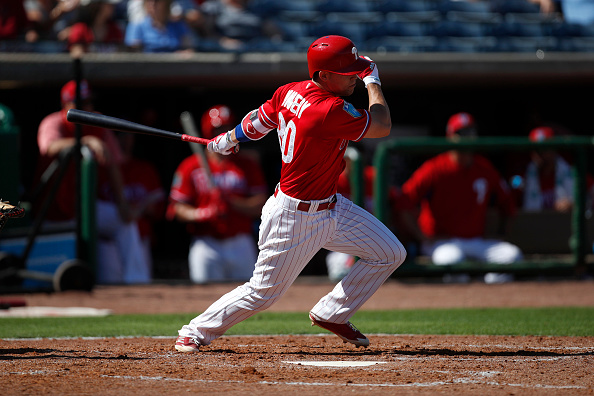
Published: Mar 27, 2018
Top prospect and spring training phenom Scott Kingery not only played his way onto the roster, but agreed to the highest salary by a player yet to make his debut with a guaranteed $24 million dollars over the next three years with three more team options which could result in a total approaching $65 million. This means Kingery will break camp with the team and not be subject to the Super 2 rules which almost assuredly meant he would head to the minors instead of traveling with the Phillies going forward.
While there’s a ripple effect to be felt in baseball by other prospects, the last contract of this type failed miserably for Jonathan Singleton and the Astros. Like many sports, guaranteeing a player without seeing his performance at the highest level proves risky. For the Phillies, it represents a shift in how the front office operates. Not only will Kingery’s contract affect his division, it causes some potential problems for valuations of the Phillies lineup. Kingery’s contract means it’s likely new manager Gabe Kapler will not only build analytical lineups, but convert his shiny new toy into a hybrid player deploying Kingery all over the diamond.
As exciting as this can be for Kingery owners in fantasy, it could prove problematical for those who drafted Cesar Hernandez, J.P. Crawford, Maikel Franco, Odubel Herrera, Nick Williams and Aaron Altherr. Why? Refer to this tweet by team beat writer Todd Zolecki with quotes by Kapler regarding how Kingery will get into the lineup:
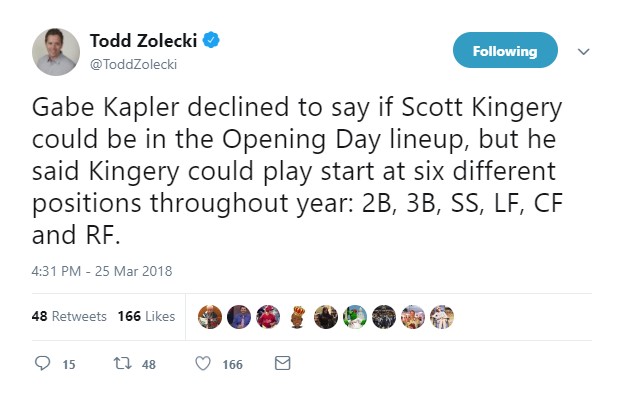
Because the Phillies do not have one spot on the field open for Kingery to take over, he will give players time off perhaps playing 4-to-5 times a week if he stays hot. This also puts players like Crawford and Franco on notice to perform this season or Kingery could displace them going forward.
Prior to going into Kingery’s potential projections, taking a look at his minor league numbers should help. After debuting in 2015, Kingery moved to High-A to start 2016 appearing in 94 games. He scored 60 runs, only hit three home runs, drove in 28 but stole 26 bases with a .293/.360/.411 slash line. Kingery moved up to Double-A to end the season but his batting average dropped by 20 points as did his on-base percentage by 27 points with his slugging cratering by almost 80 percentage points during his 156 at-bats. On the season, his total numbers settled in at .281/.335/.388 on the season with five home runs and 30 steals across the two levels. Here’s his spray chart from 2016 with credit to MLBfarm.com:
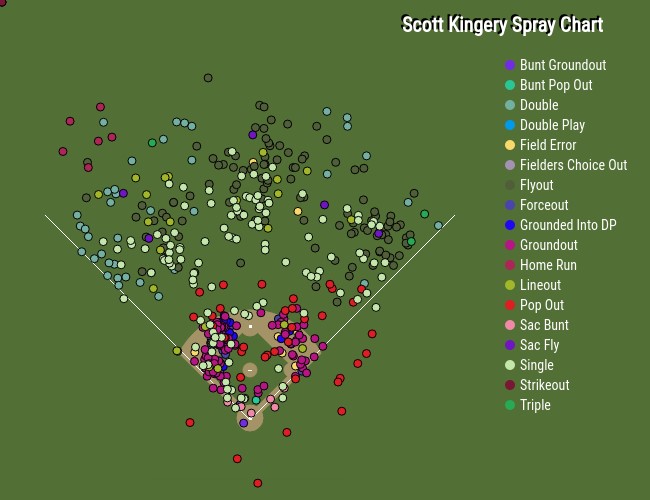
Things exploded for Kingery last year. He started the season repeating Double-A appearing in 69 games with 62 runs, 18 home runs, 44 RBI, 19 stolen bases and a .313/.379/.608 slash line. This split features his highest fly ball and home run per fly ball percentages during his short time in the minors. He then advanced to Triple-A for 63 games with 41 runs, eight home runs, 21 RBI and 10 steals with a .294/.337/.449 slash line. His totals between the two levels work out to 543 at-bats with 103 runs, 26 home runs, 65 RBI, 29 stolen bases and a .304/.359/.530 slash line. Very encouraging. Once again, here’s his spray chart with the noted spike in power:
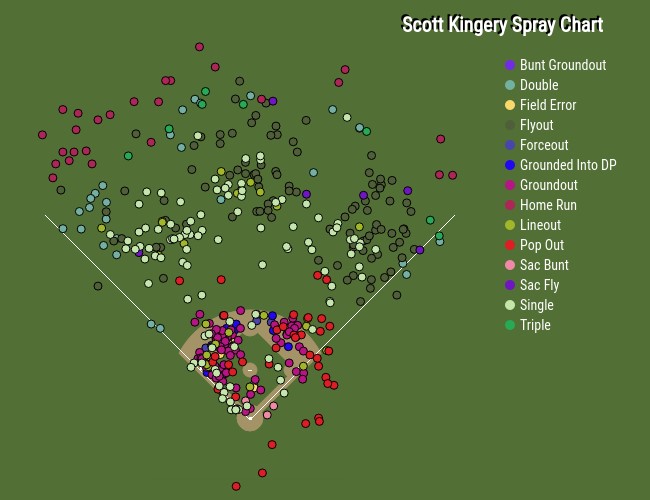
Now Kingery will try to ply his trade in the majors, without a position, in the spotlight with a contract and without failing against pitching at the top level. Yes, Kingery raked this spring through his 55 at-bats with five home runs, eight RBI, four stolen bases, a .418 average and 1.248 on-base plus slugging percentage. His numbers jump off the page. However, prior to Monday, Kingery faced competition ranked at 7.1 according to Baseball Reference. Here’s how this translates:

Most of the pitchers he faced rated between Double-A and Triple-A, which he torched last year. Yes, Kingery will hit, but how much and how well this year will be open for debate. Plus, how many strikeouts will he accumulate? While his spray chart from last year looks great above, here’s his plate appearance results from his breakout year in Double-A and Triple-A:
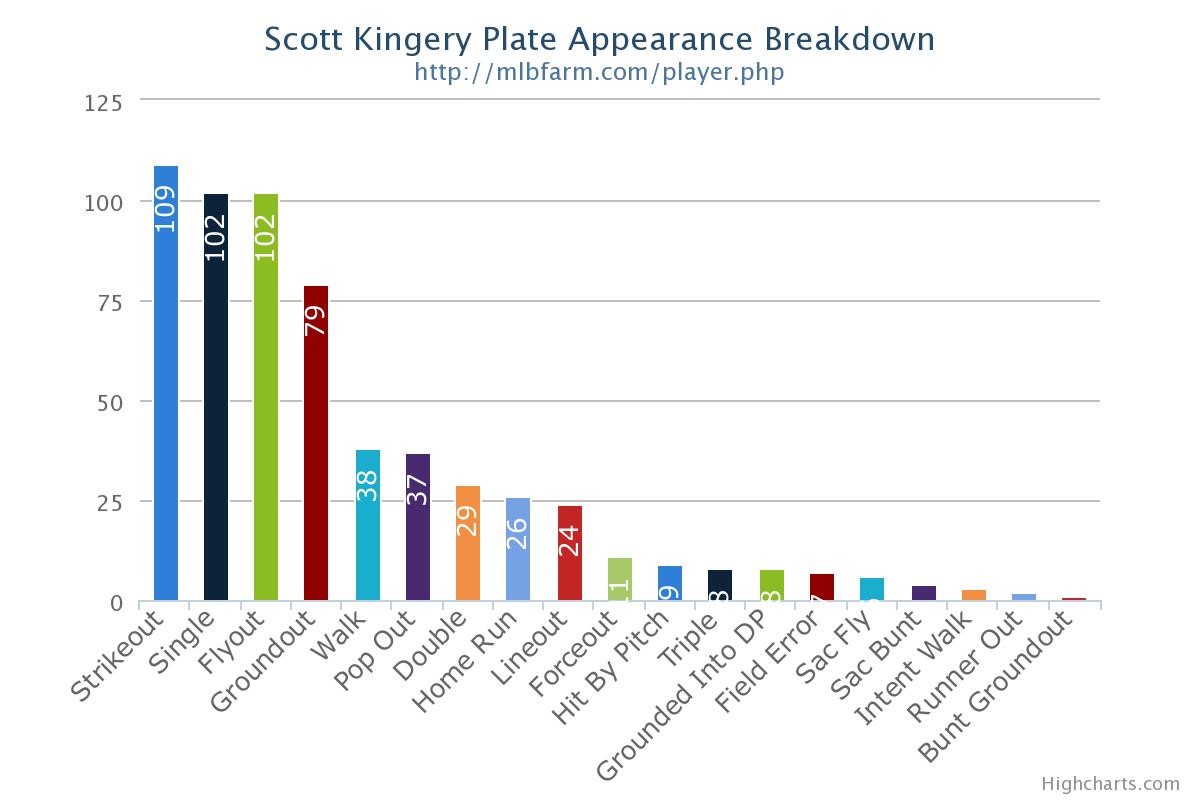
Kingery’s strikeout rate will not be egregius, but it’s worth noting. Lost in all of this, where will he play and, how often? When news broke, immediate comparisons to Ben Zobrist seemed warranted. Zobrist arrived in the majors much later, making his debut at Age-25 with the Rays. His peak season occurred in 2009 when Zobrist played in 152 games with 91 runs, 27 home runs, 91 RBI, 17 stolen bases and a .297/.405/.543 slash line. But this took place three years after his major league debut.
During the 2009 season, Zobrist played 91 games at second base, 70 total in the outfield (59 in right field, nine in left, seven in center) moving to more than one spot in a game, three games at first and one at third base. Recency bias points to Marwin Gonzalez who turned in a career year last season with 67 runs, 23 home runs, 90 RBI, eight stolen bases and a .303/.377/.530 line. Gonzalez logged 48 games in the outfield (47 in left, two in right), 38 games at shortstop, 31 at first base, 22 at second base and 19 at third base.
Kingery’s still learning the outfield on the fly, but appeared all over the infield in spring training. It’s very difficult to prognosticate how much Kingery will play nor predict what position(s) he will take at-bats away from. Production will dictate this accordingly, not only by him, but the players he’s competing for time with.
During his brief minor league career, Kingery hit .284/.341/.437 in over 1,300 at-bats with 34 home runs and 70 stolen bases. He also hit fly balls 41 percent of the time at both stops in 2016 and at Triple-A in 2017. During his time in Double-A last year, his fly ball percentage did spike to 50.4 percent, but it’s the only time during his minor league track record it hit this level. Scale his projected fly balls to roughly 40 percent, with the knowledge his home ballpark ranks highly in home runs produced.
Shifting to his projections, it’s all purely speculation. Especially in regards to playing time. Here’s a chart with three sites referenced to illustrate a baseline along with a peak since ZiPS accounts for more at-bats:

For some reason, it feels like Kingery’s numbers will land somewhere in the middle of the 340 at-bat projection range and the 536 by ZiPS. This would translate to 438, which seems a bit high, but not crazy if Philadelphia’s going to be aggressive with him. It could translate to Kingery coming closer to 13-to-14 home runs and 16 stolen bases. However, his fantasy value will ultimately depend on how well he will hit. If Kingery can exceed his averages above, it changes things appreciably.
With time running out for drafts, expect to pay the prospect tax on the hot new item in drafts. It may create bargains with other players in his range of average draft position. Due to the contract and hype, the owners who took a chance on Kingery prior to the news about his promotion stand to profit. Reaching too high for him after could create unrealistic expectations. Use the above as a baseline to keep things realistic. Kingery’s talented, but he’s an unproven commodity with some regression in his spring numbers lying in wait.
----------------------------------------------------------------------------------------------------------
Statistical Credits:
Fangraphs.com, MiLB.com, Baseball-Reference.com, MLBfarm.com, THE BAT courtesy of Derek Carty, ZiPS courtesy of Dan Szymborski, Steamerprojections.com, Contract details
